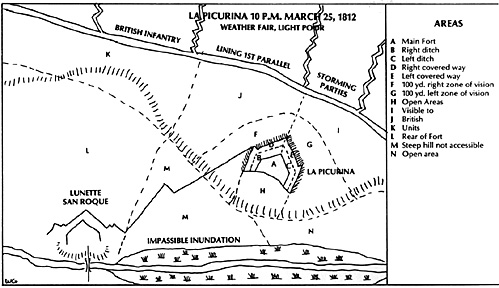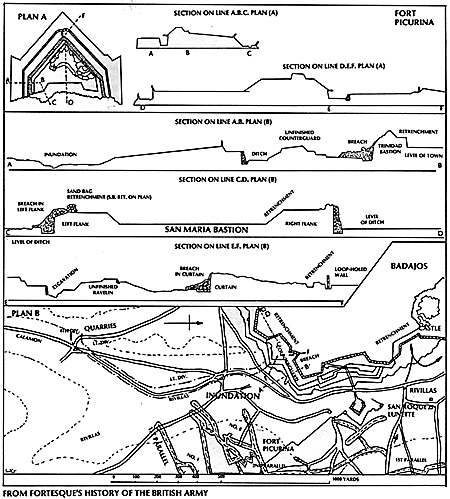 La Picurina was an important outwork of the Spanish fortified city of
Badajos. Built according to the geometric precepts of the late Seventeenth
Century, the fort occupied a hill overlooking the main enceinte of the city. In
1812 the able Governor of Badajos, General Armand Phillipon, had garrisoned
La Picurina with some 286 men, probably experienced troops from a line
regiment, or from the Graf and Erdprinz Regiment (HesseDarmstadt), under
Col. Gaspard-Thierry, together with a number of artillery pieces. During his
siege of March of that year, the Duke of Wellington had selected the Picurina
position as his approach to the city.
La Picurina was an important outwork of the Spanish fortified city of
Badajos. Built according to the geometric precepts of the late Seventeenth
Century, the fort occupied a hill overlooking the main enceinte of the city. In
1812 the able Governor of Badajos, General Armand Phillipon, had garrisoned
La Picurina with some 286 men, probably experienced troops from a line
regiment, or from the Graf and Erdprinz Regiment (HesseDarmstadt), under
Col. Gaspard-Thierry, together with a number of artillery pieces. During his
siege of March of that year, the Duke of Wellington had selected the Picurina
position as his approach to the city.
Accordingly, a first parallel was traced on the night of the 17th, only 160-200 yards from the covered way of the fort. Heavy rain dogged the progress of the siege, and a sortie by 1000 men on the 19th was only beaten off by the British work-parties at the cost of many lost tools. Not until March 24th were the British gunners able to begin battering La Picurinal destroying its artillery and the palisade defences of the covered way. Except for a partial breaching of the salient point of the fort, La Picurina itself was hardly damaged. Exasperated at the slow advance of the siege, Wellington ordered an assault for 10 p.m. on March 25.
British Forces: 500 men from various units of the 3rd and light divisions under Major-General James Kempt. Of these, 100 may be designated "Good Troops" as volunteers of the "Storming Party".
1000 men lining the length of the parallel to watch for a sortie from the Lunette San Roque or cover a retreat by the assault column. These troops will not advance beyond their current position, unless the French sortie recaptures "La Picurina".
French Forces: 286 men holding La Picurina. 500 men ready in the city for a sortie. From turn 4 onwards roll 1 die per turn. For a 6 they will emerge via the Lunette San Roque to reinforce/retake La Picurina.
SPECIAL SCENARIO RULES
A. The covered way counts "+1 defending wall" for the French. The garrison may pass freely between the main fort and the covered way in one turn without crossing the ditch, by means of temporary bridges; these bridges will be broken if the British try to use them!
B. The gorge (rear) of the fort is an unknown area to the British. Attackers reaching the gorge roll 1d6;
- 1 No obstacle - free entry to attackers.
2,3,4 counts as "obstacle -V to attackers. No rampart advantage for defenders.
5,6 Requires ladders to climb. No rampart advantage.
The medieval castle and later city wall showing the covered way and an intact ravelin.
C. The sides of the fort have a deep but narrow ditch. Attackers roll 1d6;
- 1 Ladders too short to reach either bottom of ditch or other side. Sorry!
2,3,4 Normal descent of ditch; scale wall next turn.
5,6Attackers place ladders directly from covered way to wall, bypassing ditch. Attackers -1 on ladders, defender +1 behind rampart.
D. The breach at the fort salient is wide enough for 5 figures at "-1 obstacle" since the breach is not yet complete, not "practicable" in siege terminology.
E. The French sortie from San Roque passes in front of the British parallel for 2 turns. For each French " kill" roll 1d6. A 6 causes the French to call off the assault; otherwise they attack La Picurina.
F. Scales used by our group using 15mm troops were 1" =30 yds., 1 figure=15 men; this gives a quick game of about an hour. A big table, 25mm troops or a lot of time might call for, say, 1" =10 or 20 yards and 1 figure=8 or 10 men.
The British win if they possess La Picurina byturn 10; the French win if they control the main fort on turn 10. Otherwise, it's a draw. Weather is fair, light is poor.
WHAT REALLY HAPPENED!
The British force was divided into four groups; a storming party, a reserve of 100 men, and two turning columns ordered to break in at the gorge. Finding the rear of La Picurina a very difficult proposition, with a double palisade and cutting, one column desperately tried placing 3 ladders across the ditch at the right flank of the fort, and 50 men under the gallant Captain Oates of the 88th, ran across the sagging rungs. At the same time the reserve of the storming party, mainly from the 2/83rd, finally broke in at the salient after a fiercely contested passage of the deep ditch. The garrison lost 83 casualties, 145 prisoners including Caspard-Thierry; only 40 or so men escaped into the city.
The attackers lost heavily; 54 killed and 265 wounded out of 500 men, 100 of which became casualties before the stormers reached the ditch. The French sortie launched as the fort fell, lost 50 men to fire from the infantry in the British trenches, and withdrew rather than sustain further loss.
Wellington thus gained La Picurina, and began emplacing batteries there the following day.
As a wargame, "La Picurina" is a finely balanced action in which neither side has the luxury of enough men to ensure against a few unlucky twists of fate. Our small group in Savannah achieved a result quite uncannily similar to the actual storm, the British losing a few less men than in real life. Our 'Kempt', John Kennington, put this down to a few 6's at the right time. My suspicion is that Sir James Kempt had a good deal of luck himself that March night in 1812.

More Forlorn Hope
Back to Table of Contents -- Courier Vol. VII #6
To Courier List of Issues
To MagWeb Master Magazine List
© Copyright 1987 by The Courier Publishing Company.
This article appears in MagWeb (Magazine Web) on the Internet World Wide Web.
Other military history articles and gaming articles are available at http://www.magweb.com